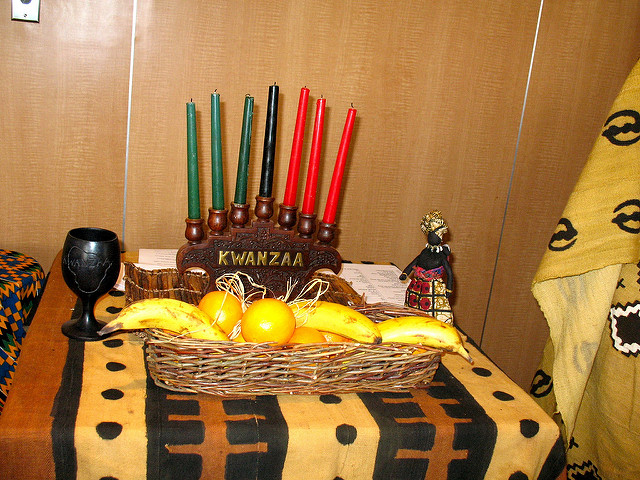December 26, 2018 - January 1, 2019 - Kwanzaa
Kwanzaa is celebrated from December 26 through January 1. It is an African American and Pan-African holiday which celebrates family, community and culture. The holiday was created in 1966 by Dr. Maulana Karenga, professor of Africana Studies at California State University, Long Beach. He is an author and he was an activist during the Black Liberation Movement. The goal of Kwanzaa was to preserve, revitalize, and promote African American culture.
The name Kwanzaa comes from the phrase "matunda ya kwanza" which means "first fruits" in Swahili. The phrase refers to the first harvest celebrations of Africa. The first-fruits celebrations go as far back as ancient Egypt and appear in other African civilizations. Kwanzaa builds on the five fundamental activities of "first fruit" celebrations: ingathering, reverence, commemoration, recommitment, and celebration.
The Seven Principles of Kwanzaa
Each day of Kwanzaa emphasizes a different principle. The seven principles, or Nguzo Saba, were a set of ideals created by Dr. Maulana Karenga.
The Seven Principles are:
Unity: Umoja (oo–MO–jah)
To strive for and maintain unity in the family, community, nation, and race.
Self-determination: Kujichagulia (koo–gee–cha–goo–LEE–yah)
To define ourselves, name ourselves, create for ourselves, and speak for ourselves.
Collective Work and Responsibility: Ujima (oo–GEE–mah)
To build and maintain our community together and make our brother’s and sister’s problems our problems and to solve them together.
Cooperative Economics: Ujamaa (oo–JAH–mah)
To build and maintain our own stores, shops, and other businesses and to profit from them together.
Purpose: Nia (nee–YAH)
To make our collective vocation the building and developing of our community in order to restore our people to their traditional greatness.
Creativity: Kuumba (koo–OOM–bah)
To do always as much as we can, in the way we can, in order to leave our community more beautiful and beneficial than we inherited it.
Faith: Imani (ee–MAH–nee)
To believe with all our heart in our people, our parents, our teachers, our leaders, and the righteousness and victory of our struggle.
The Symbols of Kwanzaa
Kwanzaa also has seven basic symbols and two supplemental ones. Each represents values and concepts reflective of African culture. And they aim to encourage community building and reinforcement.
The Basic Symbols
The basic symbols in Swahili and then in English are:
Mazao (The Crops)
These are symbolic of African harvest celebrations and of the rewards of productive and collective labor.
Mkeka (The Mat)
This is symbolic of our tradition and history and therefore, the foundation on which we build.
Kinara (The Candle Holder)
This is symbolic of our roots, our parent people -- continental Africans.
Muhindi (The Corn)
This is symbolic of our children and our future which they embody.
Mishumaa Saba (The Seven Candles)
These are symbolic of the Nguzo Saba, the Seven Principles, the matrix and minimum set of values which African people are urged to live by in order to rescue and reconstruct their lives in their own image and according to their own needs.
Kikombe cha Umoja (The Unity Cup)
This is symbolic of the foundational principle and practice of unity which makes all else possible.
Zawadi (The Gifts)
These are symbolic of the labor and love of parents and the commitments made and kept by the children.
The Supplemental Symbols
The two supplemental symbols are:
Bendera (The Flag)
Nguzo Saba Poster (Poster of The Seven Principles)
Kwanzaa Colors
The colors of the Kwanzaa flag are the colors of the Organization Us. They are black, red and green. Black is for the people, red for their struggle, and green for the future and hope that comes from their struggle. It is based on the colors given by the Honorable Marcus Garvey as national colors for African people throughout the world.
How Kwanzaa is Celebrated
There are very particular guidelines to celebrating Kwanzaa. First, those participating should do so with a profound respect for its values, symbols and practices, and do nothing to violate its integrity, beauty and expansive meaning. Second, they should not mix the Kwanzaa holiday or its symbols, values and practice with any other culture. Finally, they should choose the best and most beautiful items to celebrate Kwanzaa, and they should use the colors of the flag in decorations that include traditional African items. Gifts are given during this time as well, but mainly to children. These gifts must always include a book and a heritage symbol. The book is to emphasize the African value and tradition of learning stressed since ancient Egypt. The heritage symbol is to reaffirm and reinforce the African commitment to tradition and history.
Kwanzaa is a cultural holiday and not a religious one. Therefore, Africans of all religious faiths are welcome practice.
Learn more about Kwanzaa with the books below
If there's a particular celebration you or someone you know participates in that we missed, let us know by leaving a comment on this post. Or, if you think we got something wrong, please also comment and let us know. We try to be as accurate as possible, but if there's a mistake, we want to correct it.




Add a comment to: The Origins and Practices of Holidays: Kwanzaa